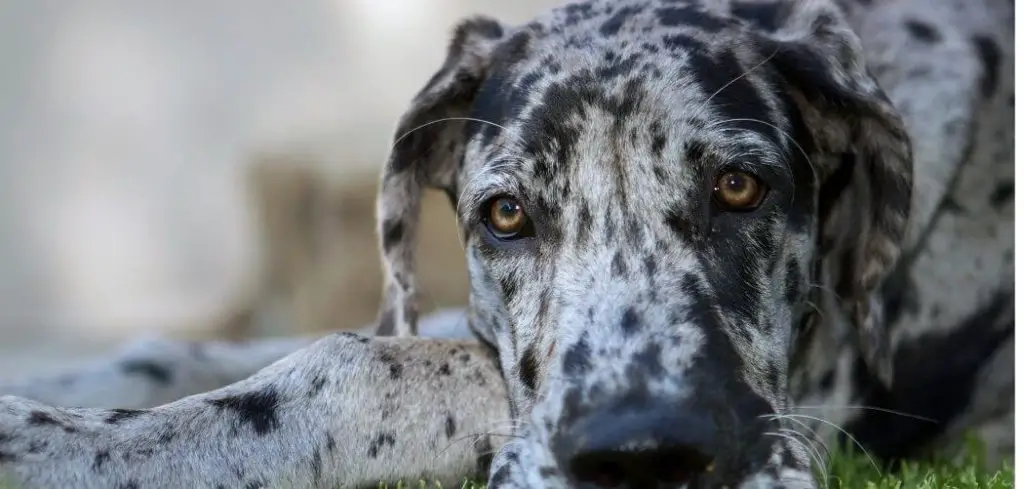When your dog looks bloated but shows no other symptoms, it can leave you feeling unsure and concerned.
A swollen abdomen can sometimes seem minor, but it may also signal an underlying issue that needs attention.
We outline the common reasons for dog bloating with no other symptoms, what you can do at home, and when to seek veterinary help.
Dog Bloated No Other Symptoms — Why It Happens
A dog that appears bloated without other symptoms may be dealing with gas buildup, overeating, intestinal blockage, organ enlargement, or a condition like early bloat (gastric dilatation). Some dogs may show only abdominal swelling at first, with other warning signs developing later.
In many cases, the lack of additional symptoms makes it more challenging to judge whether it’s a benign issue or something urgent.

Dog Bloated No Other Symptoms: Common Causes
Overeating or Rapid Eating
Dogs that eat too quickly or consume a large meal may temporarily look bloated. When a dog gulps down food, air can become trapped in the stomach, causing distension.
You might notice your dog’s belly looks round and firm, but otherwise, they act normal. This type of bloating often subsides within a few hours as digestion progresses.
While it may seem harmless, chronic overeating or gulping food can increase the risk of more serious conditions like gastric dilatation-volvulus (GDV) in deep-chested breeds.
Read more: Dog Shaking and Not Eating (Here’s Why)
Gas and Indigestion
Gas buildup is one of the most common and benign reasons for a dog looking bloated with no other symptoms. This can happen if a dog eats something unusual, has a minor digestive upset, or swallows air during play.
Signs include a visibly swollen abdomen, occasional gurgling noises, and sometimes passing gas. Dogs usually continue acting normal, but the appearance of the belly may worry owners.
Though usually mild, frequent bloating from gas could point to food intolerance, poor diet, or even intestinal parasites that should be checked by a vet.
Intestinal Obstruction (Early Stages)
A dangerous but subtle cause of bloating is a partial intestinal blockage. Dogs that swallow foreign objects — toys, bones, fabric, or sticks — can develop swelling before other symptoms appear.
At first, your dog may just look bloated with no vomiting or lethargy. However, as the blockage progresses, serious signs such as loss of appetite, pain, or vomiting usually develop.
This is why a “wait and see” approach can be risky when a dog has unexplained abdominal swelling. What begins as mild bloating may quickly escalate into a life-threatening emergency.
Organ Enlargement
Sometimes, a dog’s belly looks swollen because an internal organ is enlarged. Conditions like liver disease, kidney issues, or tumors can cause gradual distension without obvious discomfort.
Dogs may appear otherwise normal at first, only showing swelling as the disease progresses. Over time, you might notice subtle changes like reduced stamina, mild appetite loss, or increased drinking.
Because organ enlargement can stem from serious health problems, persistent bloating always deserves veterinary attention, even if your dog seems fine otherwise.
Fluid Build-Up (Ascites)
Ascites is the medical term for fluid accumulation in the abdomen. This can be caused by heart disease, liver failure, cancer, or other systemic problems.
Early on, a dog with ascites may simply look bloated but act normal. The swelling can feel soft or fluid-like when touched, unlike the firm distension seen in gas or food bloat.
Even if your dog is behaving normally, fluid in the abdomen almost always signals a significant underlying condition that should be investigated quickly.
Gastric Dilatation (Early Stage Bloat)
Bloat, or gastric dilatation-volvulus (GDV), is one of the most feared causes of abdominal swelling in dogs. In its earliest stage, a dog may only show a bloated belly with no other symptoms.
As the stomach fills with gas and expands, it can twist, cutting off blood supply and leading to shock. Dogs may initially act normal, but within hours, signs such as restlessness, drooling, and attempts to vomit appear.
Large, deep-chested breeds like Great Danes, German Shepherds, and Boxers are at the highest risk. Even without other symptoms, sudden bloating in these dogs should always be treated as an emergency.
What to Do If Your Dog Is Bloated No Other Symptoms
If your dog appears bloated but otherwise acts normal, start by observing closely. Sometimes mild bloating after a meal or play session will settle naturally.
Make sure your dog has access to water but avoid offering more food until the swelling improves. Encourage rest and avoid vigorous exercise that could worsen stomach pressure.
If you suspect overeating or rapid eating, consider feeding smaller, more frequent meals and using slow-feeder bowls to reduce gulping.
However, don’t ignore persistent or unexplained bloating. Even if your dog looks comfortable, subtle swelling can sometimes be the first sign of a serious condition. When in doubt, call your veterinarian for guidance.
When to Call or Visit Your Vet
Seek immediate veterinary care if your dog’s bloating:
Appears suddenly and is severe.
Occurs in a deep-chested breed.
Is accompanied by retching, drooling, or restlessness.
Feels firm or tight to the touch.
Persists for more than a few hours without improvement.
Also call your vet if the bloating recurs frequently or if your dog develops additional symptoms like loss of appetite, lethargy, or difficulty breathing.
Since many serious conditions start with mild or vague signs, it’s always safer to have abdominal swelling checked early.
Read more: Dog Shaking No Other Symptoms (What it could mean)
Key Takeaway
A dog bloated with no other symptoms can be unsettling because it’s unclear whether the cause is harmless or serious.
While overeating or mild gas may explain some cases, conditions like intestinal blockages, fluid buildup, or early bloat can also present this way.
Always monitor closely, make small adjustments at home, and contact your vet if swelling is sudden, severe, or persistent. Your caution could make all the difference in keeping your dog safe and healthy.
